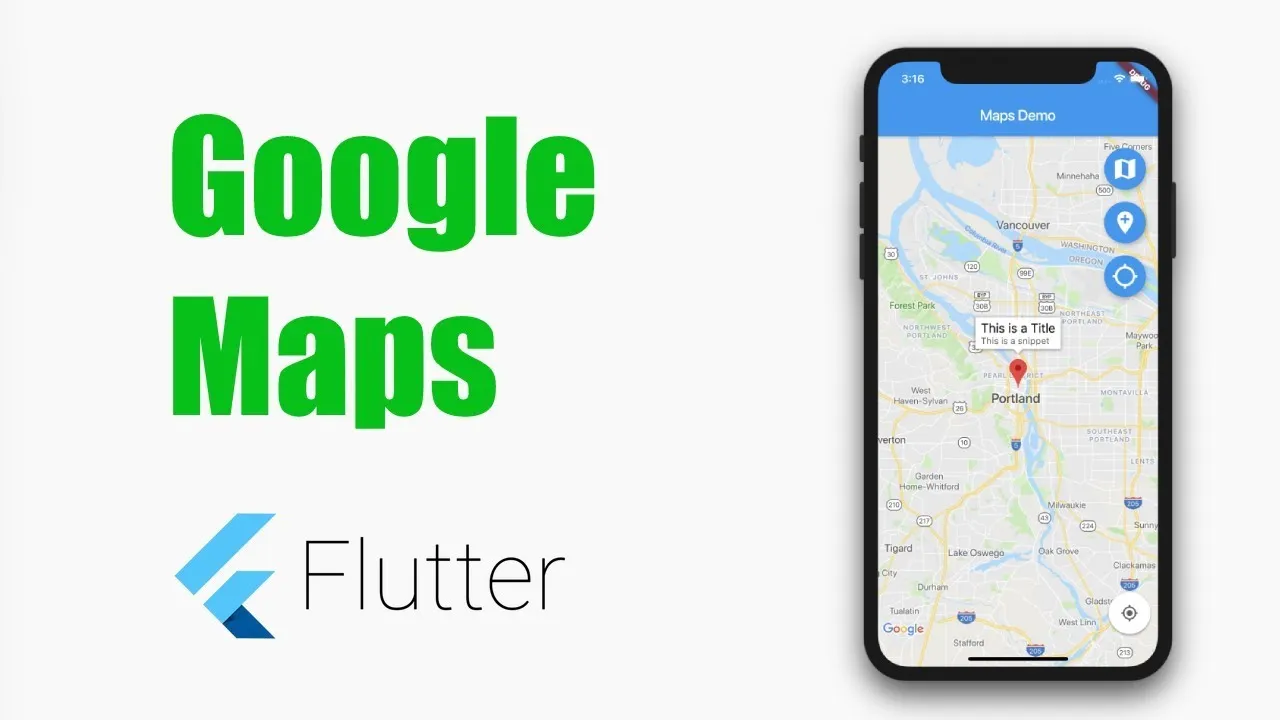A Flutter Plugin For Integrating Google Maps In IOS And Android Apps
Google Maps for Flutter
A Flutter plugin that provides a Google Maps widget.
| Android | iOS | Web | |
|---|---|---|---|
| Support | SDK 20+ | iOS 11+ | Same as Flutter's |
Usage
To use this plugin, add google_maps_flutter as a dependency in your pubspec.yaml file.
Getting Started
Get an API key at https://cloud.google.com/maps-platform/.
Enable Google Map SDK for each platform.
- Go to Google Developers Console.
- Choose the project that you want to enable Google Maps on.
- Select the navigation menu and then select "Google Maps".
- Select "APIs" under the Google Maps menu.
- To enable Google Maps for Android, select "Maps SDK for Android" in the "Additional APIs" section, then select "ENABLE".
- To enable Google Maps for iOS, select "Maps SDK for iOS" in the "Additional APIs" section, then select "ENABLE".
- To enable Google Maps for Web, enable the "Maps JavaScript API".
- Make sure the APIs you enabled are under the "Enabled APIs" section.
For more details, see Getting started with Google Maps Platform.
Android
- Set the
minSdkVersioninandroid/app/build.gradle:
android {
defaultConfig {
minSdkVersion 20
}
}
This means that app will only be available for users that run Android SDK 20 or higher.
- Specify your API key in the application manifest
android/app/src/main/AndroidManifest.xml:
<manifest ...
<application ...
<meta-data android:name="com.google.android.geo.API_KEY"
android:value="YOUR KEY HERE"/>
Display Mode
The Android implementation supports multiple platform view display modes. For details, see the Android README.
iOS
To set up, specify your API key in the application delegate ios/Runner/AppDelegate.m:
#include "AppDelegate.h"
#include "GeneratedPluginRegistrant.h"
#import "GoogleMaps/GoogleMaps.h"
@implementation AppDelegate
- (BOOL)application:(UIApplication *)application
didFinishLaunchingWithOptions:(NSDictionary *)launchOptions {
[GMSServices provideAPIKey:@"YOUR KEY HERE"];
[GeneratedPluginRegistrant registerWithRegistry:self];
return [super application:application didFinishLaunchingWithOptions:launchOptions];
}
@end
Or in your swift code, specify your API key in the application delegate ios/Runner/AppDelegate.swift:
import UIKit
import Flutter
import GoogleMaps
@UIApplicationMain
@objc class AppDelegate: FlutterAppDelegate {
override func application(
_ application: UIApplication,
didFinishLaunchingWithOptions launchOptions: [UIApplication.LaunchOptionsKey: Any]?
) -> Bool {
GMSServices.provideAPIKey("YOUR KEY HERE")
GeneratedPluginRegistrant.register(with: self)
return super.application(application, didFinishLaunchingWithOptions: launchOptions)
}
}
Web
You'll need to modify the web/index.html file of your Flutter Web application to include the Google Maps JS SDK.
Check the google_maps_flutter_web README for the latest information on how to prepare your App to use Google Maps on the web.
All
You can now add a GoogleMap widget to your widget tree.
The map view can be controlled with the GoogleMapController that is passed to the GoogleMap's onMapCreated callback.
The GoogleMap widget should be used within a widget with a bounded size. Using it in an unbounded widget will cause the application to throw a Flutter exception.
Sample Usage
class MapSample extends StatefulWidget {
const MapSample({super.key});
@override
State<MapSample> createState() => MapSampleState();
}
class MapSampleState extends State<MapSample> {
final Completer<GoogleMapController> _controller =
Completer<GoogleMapController>();
static const CameraPosition _kGooglePlex = CameraPosition(
target: LatLng(37.42796133580664, -122.085749655962),
zoom: 14.4746,
);
static const CameraPosition _kLake = CameraPosition(
bearing: 192.8334901395799,
target: LatLng(37.43296265331129, -122.08832357078792),
tilt: 59.440717697143555,
zoom: 19.151926040649414);
@override
Widget build(BuildContext context) {
return Scaffold(
body: GoogleMap(
mapType: MapType.hybrid,
initialCameraPosition: _kGooglePlex,
onMapCreated: (GoogleMapController controller) {
_controller.complete(controller);
},
),
floatingActionButton: FloatingActionButton.extended(
onPressed: _goToTheLake,
label: const Text('To the lake!'),
icon: const Icon(Icons.directions_boat),
),
);
}
Future<void> _goToTheLake() async {
final GoogleMapController controller = await _controller.future;
await controller.animateCamera(CameraUpdate.newCameraPosition(_kLake));
}
}
See the example directory for a complete sample app.
Use this package as a library
Depend on it
Run this command:
With Flutter:
$ flutter pub add google_maps_flutterThis will add a line like this to your package's pubspec.yaml (and run an implicit flutter pub get):
dependencies:
google_maps_flutter: ^2.3.1Alternatively, your editor might support flutter pub get. Check the docs for your editor to learn more.
Import it
Now in your Dart code, you can use:
import 'package:google_maps_flutter/google_maps_flutter.dart';// Copyright 2013 The Flutter Authors. All rights reserved.
// Use of this source code is governed by a BSD-style license that can be
// found in the LICENSE file.
import 'package:flutter/material.dart';
import 'package:google_maps_flutter_android/google_maps_flutter_android.dart';
import 'package:google_maps_flutter_platform_interface/google_maps_flutter_platform_interface.dart';
import 'animate_camera.dart';
import 'lite_mode.dart';
import 'map_click.dart';
import 'map_coordinates.dart';
import 'map_ui.dart';
import 'marker_icons.dart';
import 'move_camera.dart';
import 'padding.dart';
import 'page.dart';
import 'place_circle.dart';
import 'place_marker.dart';
import 'place_polygon.dart';
import 'place_polyline.dart';
import 'scrolling_map.dart';
import 'snapshot.dart';
import 'tile_overlay.dart';
final List<GoogleMapExampleAppPage> _allPages = <GoogleMapExampleAppPage>[
const MapUiPage(),
const MapCoordinatesPage(),
const MapClickPage(),
const AnimateCameraPage(),
const MoveCameraPage(),
const PlaceMarkerPage(),
const MarkerIconsPage(),
const ScrollingMapPage(),
const PlacePolylinePage(),
const PlacePolygonPage(),
const PlaceCirclePage(),
const PaddingPage(),
const SnapshotPage(),
const LiteModePage(),
const TileOverlayPage(),
];
/// MapsDemo is the Main Application.
class MapsDemo extends StatelessWidget {
/// Default Constructor
const MapsDemo({super.key});
void _pushPage(BuildContext context, GoogleMapExampleAppPage page) {
Navigator.of(context).push(MaterialPageRoute<void>(
builder: (_) => Scaffold(
appBar: AppBar(title: Text(page.title)),
body: page,
)));
}
@override
Widget build(BuildContext context) {
return Scaffold(
appBar: AppBar(title: const Text('GoogleMaps examples')),
body: ListView.builder(
itemCount: _allPages.length,
itemBuilder: (_, int index) => ListTile(
leading: _allPages[index].leading,
title: Text(_allPages[index].title),
onTap: () => _pushPage(context, _allPages[index]),
),
),
);
}
}
void main() {
final GoogleMapsFlutterPlatform mapsImplementation =
GoogleMapsFlutterPlatform.instance;
if (mapsImplementation is GoogleMapsFlutterAndroid) {
mapsImplementation.useAndroidViewSurface = true;
}
runApp(const MaterialApp(home: MapsDemo()));
}Download details:
Author: flutter.dev
Source: https://github.com/flutter/packages/tree/main/packages/google_maps_flutter/google_maps_flutter
#flutter #android #ios #web-development #web #google #google-maps
